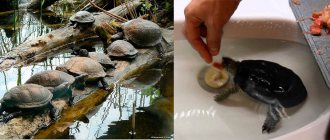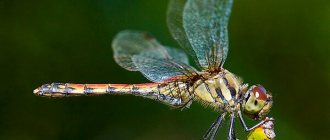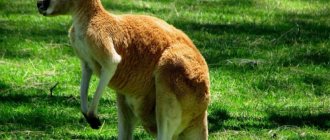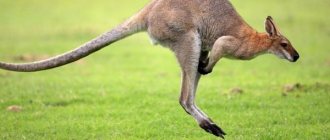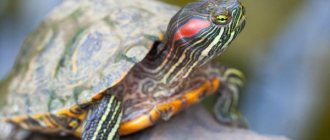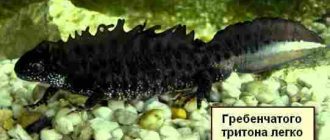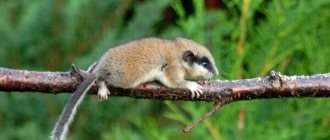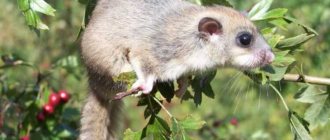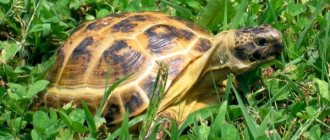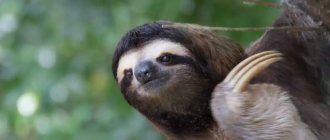The turtle is a representative of the class of reptiles. The main feature of the animal is the presence of a shell. This element protects him from enemy attacks.
The shell is very durable and covers both the back and abdomen.
Some species of turtles can reach a body weight of more than 900 kilograms, and the weight of the smallest representatives of the species is no more than 125 grams.
Knobby humpback
In the fresh lakes and rivers of the states of Alabama and Mississippi there lives an unusual and beautiful turtle that does not grow more than 20 centimeters.
Its distinctive feature is the original shape of the shell, which has several spikes. In addition, the shell is hemispherical, which gives the turtle a slight humpback.
Nature has rewarded her with such a shell, since the cute turtle cannot retract her head, and the spines remain the only means of protection from enemies.
2
Prickly
One of the rarest species, found only in certain areas of Southeast Asia. You can meet this turtle in the wetlands of tropical rainforests.
What makes it unusual is the unusual shape of its shell. The outer shields protrude far to the side, thus forming protective spikes. Yes, and there are small shoots on the back.
The spiny turtle feeds exclusively on berries and earthworms. In captivity, it can also eat pieces of meat, becoming truly omnivorous.
3
What to feed at home
Turtles need to be provided with a balanced diet. Can you feed land turtles?
leaves of cabbage, dandelion, pulp of apples, cucumbers, tomatoes. To meet the need for protein food, they can be given boiled chicken eggs and vitamin supplements.
Feeding aquatic turtles will be a little more difficult, because they need small animals; you can feed them with dried daphnia, bloodworms, earthworms, boiled chicken or beef. They will not mind eating various insects, cockroaches, and small aquarium fish.
Adult turtles need to be fed once a day, young turtles twice a day and a so-called fasting day once a week.
Leatherback turtle
Photo above: A baby leatherback turtle just hatched from its egg. In the photo below: Adult
In many popular tourist destinations you can swim next to these amazing animals and you are sure to get a lot of positive emotions. They are so unusual that they have a leather shell rather than a hard bone shell.
This turtle seems very cute, but only until you look into its mouth.
In the photo: in the mouth of a leatherback turtle
4
Types of sea turtles
Sea dwellers are usually much larger than their land-based relatives. They are more common in the tropics and are more comfortable in warm water. In cold northern latitudes they are very rare. According to scientists who studied fossil remains, they have remained virtually unchanged for many millions of years.
They are characterized by well-developed front paws, which they use as flippers. Their hind legs practically do not help them swim. Their limbs do not retract into the shell. By the way, several species of marine reptiles do not have a shell at all, for example, the leatherback turtle. In the water element they are extremely mobile, and they develop exceptional speed, are very dexterous and have excellent orientation in the sea.
The most famous species of sea turtles :
1. Leatherback turtles . The only remaining species from the entire family. They can be considered the largest of the turtle order, the size of these creatures reaches 2.6 m. Their weight reaches 900 kg, they are omnivores. In addition, they are considered to be wider than all vertebrates on Earth. These “crumbs” can bite and are so strong that they can even break bone tissue.
They do not attack humans themselves, but they show aggression if they are deliberately angered. They tell of one case when such a huge turtle attacked a small fishing boat and capsized it. True, before this it was noticed that a shark was chasing her for a long time. The fishermen were probably just on the escape route, and she mistook them for a threat.
2. Green soup sea turtles . Typically found in tropical Pacific and Atlantic latitudes. Contrary to the name, their color is not only green, but also chocolate with streaks and spots the color of egg yolk. Young individuals spend their lives in the open sea, hunting fish and other sea inhabitants. By old age, they move to land and become herbivores.
3. Loggerhead sea turtles (false sea turtles), or loggerheads. They grow to a size of 95 cm, while weighing about 200 kg. The outline of the carapace resembles a large heart, the color is soft coffee, terracotta or pistachio. The lower shield is cream or yellow. The forelimbs-flippers are equipped with a pair of claws.
The head is large, decorated with noticeable shield plates. It lives in the warm subtropical sea zone of the Earth; for nesting, it slightly expands its habitat, capturing zones with a temperate climate. The largest population is seen in the Arabian Sea on an island called Masirah.
4. Hawksbill sea turtles (true carriage turtles). They are a bit like green turtles, but they are smaller in size. Their habitat is located between the temperate climate zones of the Northern and Southern Hemispheres. They can be seen off the foggy lands of Great Britain, the rocky coasts of Scotland, in the east they are found in the Sea of Japan, they have been seen in the southern cape of Africa, near Tasmania and New Zealand.
They spend their entire lives at sea, and come ashore exclusively to reproduce. Such periods occur only once every three years or so, and they undergo long migrations to swim to their native nesting sites. Recently it was noticed that they sometimes emit a glow in water (prone to fluorescence).
5. Olive or Ridley turtles . They are also lovers of warm latitudes, and also do not leave the sea all their lives. Their breeding season is very remarkable. They lay eggs once a year at the same time, all on the same day, and in the same place. They all gather on the seashore on this single day, forming a large gathering.
The Aborigines call this phenomenon the “turtle invasion.” Each of the parents carefully buries her eggs, camouflages, smoothes the surface, and tries as much as possible to make the laying site unnoticeable. Then, with a calm soul, he goes off to the open sea. And the eggs remain lying in the sand until babies begin to hatch from them.
There are a lot of eggs, but the babies have a very low survival rate. Small turtles immediately rush to the water, and on the way land predators are already waiting for them. The surviving babies dive into the saving water. And there sea predators are waiting for them. Only dozens of the hundreds of hatched babies remain. And perhaps only one in a hundred will live to see six months and return to the same shore to lay eggs themselves.
Mata-mata
The Mata Mata (Chelus fimbriatus) has a unique and unusual appearance that makes the animal a master of camouflage. They live in the silty waters of South America.
Due to its unusualness and ease of maintenance, the species is very popular among terrarium enthusiasts.
6
Soft-shelled Chinese
One can argue about the beauty of this species, but the fact that it is one of the most unusual is indisputable.
What distinguishes the inhabitant of China and other Asian countries from its relatives is its soft shell. Surprisingly, breathing with its lungs, this turtle can stay under water for a long time.
Scientists have not yet figured out how she manages this, but they recently learned another feature of hers - they urinate through the mouth.
By the way, on our website most-beauty.ru you can see other equally strange and unusual animals on the planet.
7
Enemies in nature
Speaking of enemies, in natural conditions the main enemies of a turtle are some birds of prey (eagles,
hawks), which grab small turtles, lift them to a great height, from there they throw them onto stones and peck out their entrails from their broken shells.
Interesting fact: the great ancient Greek playwright Aeschylus died an extremely ridiculous death, he was killed by a turtle that fell on his head. The eagle, having lifted the turtle to a height, mistakenly considered the playwright's bald head to be a large stone suitable for breaking the turtle's shell.
Death of Aeschylus by an eagle and a turtle.
As for giant turtles, given their weight and size, they have no enemies in nature. Even people are increasingly treating these majestic, long-lived creatures with due respect.
Red-bellied Shortneck
Photo credit: Petra Karstedt / wikipedia
This graceful, sleek turtle with a small head and interesting webbed feet is native to New Guinea, as well as a small region of Australia.
In the photo: Baby red-bellied short-necked turtle
We recommend watching: Amazing animals endemic to Australia.
8
Elusor macrurus
This endangered species of turtle can only be found in one corner of the Earth. They are found in the Mary River, which flows through the expanses of Australia.
Shells come in a variety of colors and a variety of shades. What makes the head unusual is the growths under the chin, reminiscent of a small beard.
In addition, the inhabitants of river waters, being under water for so long, become overgrown with algae, which create unusual and original hairstyles on the animal’s body.
9
Eastern Longneck
In the lakes of Africa and in some eastern regions of the United States you can find a turtle that has the longest neck of the entire turtle family.
From a distance it looks very much like a snake, if not for the shell. And she hunts like a snake, sharply straightening her neck towards the prey. It can also bite a person if it considers that he is dangerous.
These are relatively small beautiful turtles, adults of which do not exceed 10–15 centimeters in length.
10
Interesting Facts
- It was turtles that were the first to fly around our moon, on board an experimental research probe launched by the Soviet Union back in 1968.
- Turtle meat is an expensive and delicious product in some cuisines around the world.
- Turtles are also present in heraldry, in the depiction of the coats of arms of some cities.
- Despite the fact that turtles do not pose a danger to humans, there are exceptions, for example, male leatherback turtles can confuse a swimmer with a female, grab them with their paws and drag them to the bottom.
- The sex of turtles in the egg is determined by the ambient temperature. At lower temperatures, males are born, at higher temperatures, females are born.
Indian lobed
Another representative of the tortoiseshell family, which, in case of danger, not only retracts its head, but also closes the front and rear flaps of the shell.
The inhabitant of freshwater bodies of India, Burma and Pakistan feeds on frogs, and can eat small mice, fish and tadpoles.
Because of its tasty meat, locals are happy to include it in their diet, but its catch is strictly limited.
11
Nutrition
The diet of turtles directly depends on their species, habitat and lifestyle. Land turtles are practically vegetarians; their main food is tree branches, fruits and grass, mushrooms and vegetables. However, it was not in vain that we wrote practically, since in order to maintain the protein balance in their bodies, turtles can sometimes eat various small animals such as snails, slugs and worms. Land turtles also drink water with pleasure.
But sea and freshwater turtles are already real predators, since their diet includes various small fish,
frogs, snails, crustaceans (some sea turtles happily eat squid, cuttlefish and other shrimp). But the gastronomic preferences of aquatic turtles are not limited to living creatures; along with them, they also eat plant foods: algae.
Interesting fact, there are species of sea turtles that eat poisonous jellyfish. From such food, the meat of the turtles themselves, in turn, becomes poisonous, which scares potential predators away from them. This is a gastronomic remedy.
Magnificent forest
The very bright color of the reptile attracts the attention of terrariumists, so the magnificent one can be found not only in the forests of Central America, but also in terrariums around the world.
The species received this name due to the unusual color of the shell. Each costal scute has red and yellow spots with a dark border, and the marginal scutes have light rings.
The omnivorous turtle includes both plant and animal foods in its diet.
12
Types of turtles
At the moment, there are about 328 species of these reptiles, they make up 14 families. A distinctive feature of the overwhelming majority of turtles is the presence of a shell consisting of a carapace (dorsal shield) and plastron (abdominal shield), movably connected to each other. These scutes are hard horny tissue, they are very durable and successfully protect the reptile from enemies and unexpected troubles.
Actually, the very name “turtle” explains to us that the animal has a peculiarity in its appearance - its shell looks like a shard (meaning the Slavic name) or a tile (according to the Latin name “testudo”). The appearance of the turtle not only confirms its name, but also proves that it was the shell that helped it survive and survive in order to reach us from distant prehistoric times.
All turtles can be divided into 2 groups according to the method of covering their heads in the shell:
- Hidden necks fold their necks in an S shape.
- Side-necks hide their heads slightly to one side, closer to any forelimb.
The next division is easier to make according to habitat.
- Sea turtles have chosen to live in the waters of the World Ocean.
- Terrestrial turtles live on land, and they can also be divided into:
- land - those who prefer to live on solid ground;
- freshwater - they inhabit fresh water bodies: rivers, ponds and swamps.
Now that we have briefly become acquainted with the basic groups, let's try to understand them in more detail and find out the names of turtle species .
Carettochelys insculpta
The pig-nosed turtle, as this species is also called because of the unusual shape of its muzzle, is one of the most remarkable and unusual representatives of the Carettochelydidae family.
It is also distinguished from its freshwater relatives by the shape of its limbs in the form of flippers, like those of the inhabitants of the deep sea. And they are found in the rivers of Australia and New Guinea.
Due to the extinction of the species, the authorities of the states in which the turtle lives have adopted strict laws to protect and increase the population of an amazing representative of the animal world. The editors of most-beauty.ru hope for a speedy restoration of the population of these beautiful turtles.
13
How to determine gender
The gender difference in turtles is so weakly expressed in appearance that it is sometimes difficult to determine whether this turtle is a “boy” or a “girl.” However, if you approach this issue with due attention, you can identify a number of signs that help determine the sex of a turtle.
1. Shell; in females the shell has a more elongated shape than in males.
2. Plastron, also known as the lower part of the shell. If you turn the turtle over, you can see that in females the lower part of the shell (the one closest to the anus) is flat, while in males it is slightly concave.
3. Tail, males have a tail that is longer and wider at the base, while “lady turtles” have a straight and short tail.
4. Claws, in males they are usually longer on the forelimbs than in females.
Spiny Trionix
This species of turtle lives in some areas of Central and North America. They grow up to 50 cm in length. Their populations are quite large, which allows people to obtain them as food. The meat of the thorny trionix is considered a delicacy.
The animal is quite aggressive both towards its relatives and towards humans.
14
Kallagur
This unusual turtle, originally from the islands of Indonesia, is unique in its biology and original appearance.
The carapace is brown with three carinae, changing color depending on the time of year. Females and males also exhibit differences in color. Because of this seasonal phenomenon, they are often called "painted" or "painted".
The head is also not without “decoration”. A bright orange stripe stretches from the tip of the nose across the entire muzzle.
15
Trionix Layta
A rather large species of Trionics Lyata with a carapace from 48 to 65 centimeters, lives in the basins of some rivers in India.
The plates have small swirls and bright spots. But the head is most painted, especially in young animals. There are longitudinal dark lines on the green muzzle, yellow spots at the corners of the mouth, and the bottom of the head is a delicate cream color.
This species was discovered back in 1872, during one of the expeditions to exotic India.
16
Geoclemys hamiltonii
Due to its unusual color, the black spotted pond turtle, which lives in the countries of Southeast Asia, is one of the most beautiful on Earth.
The carapace, with three keels with small teeth, is black with many light spots. The skin on the paws and head has the same original color as the carapace.
The beautiful turtle is a predator and feeds on snails, fish, and amphibians. Occasionally it can eat algae.
17
Types of land turtles
Such reptiles usually have a fairly high, convex shell; flat and flattened shells are rare. They also have very thick legs, like pillars. The fingers grow together, only small claws can move apart.
Their protruding parts (neck, head and paws) are most often decorated with scales and scutes. The size of these animals is in a large size range - from very small, from 12 cm in length, to huge, with a diameter of more than 1.5 m. Giant species live on the Galapagos, Seychelles and some other islands.
The saying “slow as a turtle” refers specifically to land reptiles. They are clumsy and very leisurely, they don’t even try to run away from the enemy, they simply hide in their “house”. Methods of protection and deterrence are hissing, like a snake, or sudden urination, and due to the capacity of the bladder, it is quite voluminous.
At least some animals may well be scared off. They live a long time. They usually eat plants of all kinds, but they need animal protein, so sometimes they swallow a couple of insects or invertebrates. They can go without water for a long time; they only need plant juice. But in those places where there is moisture, they try to drink enough. Consider the following types of land turtles :
1. Galapagos elephant tortoise . A real giant among land turtles, its size reaches 1.8 m and weight up to 400 kg. In addition, it is considered a recognized long-liver among vertebrates. In captivity, lifespans of up to 170 years have been recorded. It lives only on the islands whose name it bears (endemic to the Galapagos Islands).
The shell is light brown in color, and mossy lichens can grow on it over the years. The paws are large and squat, with dry skin and hard shields and scales. The carapace can be dome-shaped or saddle-shaped. This depends on the humidity of the climate - the more moisture, the higher the shell.
They feed on herbs, which are often poisonous to other animals, so meat is not recommended for food. This species has become endangered due to the development of agricultural areas; work is now underway to increase its numbers.
2. Elastic turtle . It has a flat and soft shell, formed from thin perforated bone plates. Therefore, if necessary, it can be compressed quite significantly compared to its usual dimensions. The spaces between the plates even allow you to see how the turtle breathes. Her homeland is Southern Kenya, and she also lives in Tanzania, on the northeastern coast. Prefers rocky areas of the foothills.
3. Wood turtle . Found exclusively in Canada and the northern United States. Considered a forest species. The color of the carapace is “wood-like”: gray, the protruding parts are brown-gray, the lower shield is yellow. Hence the name. They exhibit rare aggression during the breeding season. The male bites not only his rivals, but also his chosen girlfriend, trying to grab the softer parts. In winter they fall asleep. They have a mixed diet and are omnivores. They reproduce very slowly, so they risk disappearing from the face of the Earth.
4. Balkan tortoise . The carapace most often reaches 15-25 cm, rarely up to 30 cm. The upper shield has a shade of cinnamon and saffron, with dark charcoal spots. For young people it is a sunny shade, very bright, but over the years it loses its brightness and becomes darker. They are distinguished by the presence of a cone-shaped spike at the tip of the tail.
It should be noted that the western representatives are larger in size than the eastern ones. In general, their favorite habitat is the European Mediterranean (Italy, Romania, Bulgaria, a piece of Turkey and Spain, and some other islands in the sea).
5. Panther (or leopard) turtle . Its carapace is high, dome-shaped, the main shade is the color of yellow sand; in young turtles there is a noticeably pronounced, very dark pattern. Over the years it smoothes out. It lives in Africa, from Sudan to Ethiopia. Herbivore, but may, on occasion, “chew” an insect or other protein food.
6. Yellow-footed turtle (shabuti) , lives in the tropical forests of South America. The shell size is up to 60 cm, color from light to dark brown. The protruding parts are light gray. Leads a forest lifestyle and avoids open spaces. Slow, hardy, herbivorous.
7. Yellow-headed turtle (Indian oblong). It lives in northeast India, Burma, Vietnam, Laos, Thailand, Cambodia, the island of Sulawesi and the Malay Peninsula. Lives in dry forests and semi-deserts. The carapace scutes have concentric stripes, the color ranges from olive to brown, and the head is yellow. Featured on a Vietnam postage stamp.
8. Red-footed turtle (coal). A little-studied variety. The size of a tall carapace is up to 45 cm, sometimes up to 70 cm. It is painted jet black with yellow and orange spots, sometimes these spots are located in the center of the tubercles. The protruding parts of the body have a pattern of red and orange. There are also red stripes behind the eyes.
9. Radiant turtle . They have a shell of rare beauty - the carapace is very high, on a dark background there are regular geometric patterns of yellow color in the form of rays. It looks like gold embroidery on dark skin. Lives in Madagascar. Herbivorous, but does not refuse animal food on occasion.
10. Steppe tortoise or Central Asian . A land representative who settled the region of Central Asia. It feeds on plants, grass, melons, berries, and fruits. Does not consume animal food. They have a slow metabolism, this quality made it possible to choose them for research missions into space.
11. Mediterranean (Caucasian, Greek) turtle . In nature, it is represented over a fairly wide area. It has 20 subspecies, which settled in southern Europe and Asia, slightly captured the northern part of Africa and settled densely in the Black Sea region (Dagestan, Georgia, Armenia, Azerbaijan and the Russian coast of the Caucasus).
Their favorite climate is sunny and warm. Varieties may differ in size, but in general their length does not exceed 35 cm. The color can also vary, most often it is a shade of dark yellow with brown specks. They have a horny tubercle on the back of the thighs. There are 5 toes visible on the front paws, and spurs on the hind paws.
12. Egyptian tortoise . Resident of the Middle East. The yellow carapace is bordered by a dark edge. They are very small and compact compared to previous types. The size of their shell barely reaches 12 cm.
Vulture turtle
These terrifying turtles can grow up to 1.5 meters in length and weigh up to 60 kg. They live mostly in the Mississippi River basin. They feed on small fish.
Having caught one, you need to be careful; the turtle can painfully bite the offender.
18
Spur-bearing individual
The largest land turtle. The shell of an individual can reach up to 75 cm. According to some information, individuals often reach 1 meter in shell length. Females weigh about 60 kg, males - 100 kg.
Such amphibious giants live in the Sahara deserts. These are mainly herbivores that can go without water for a long time. They are characterized by rapid growth.
In captivity they can live up to 50 years. Recently, the number of turtles has sharply decreased. This is due to hunting of the species for meat.
Leopard tortoise
In the photo you see a baby leopard tortoise. This is a very common species of turtle throughout the African continent. They can be found almost everywhere: from deserts and savannas to mountainous areas.
Adults grow up to 70 cm in length, making them the second largest turtles on the continent.
19
Reproduction
For different species, the mating season begins individually for each, but has characteristic similarities. Females lay eggs in depressions in the ground and compact them with sand.
The number of eggs can range from 1 to 200 depending on the type of turtle. The incubation period varies from 2 to 3 months.

